Al-Ma'mun
Abu al-Abbas Abdallah ibn Harun al-Rashid (Arabic: أبو العباس عبد الله بن هارون الرشيد, romanized: Abū al-ʿAbbās ʿAbd Allāh ibn Hārūn ar-Rashīd; 14 September 786 – 9 August 833), better known by his regnal name al-Ma'mun (Arabic: المأمون, romanized: al-Maʾmūn), was the seventh Abbasid caliph, who reigned from 813 until his death in 833. He succeeded his half-brother al-Amin after a civil war, during which the cohesion of the Abbasid Caliphate was weakened by rebellions and the rise of local strongmen; much of his reign was consumed in pacification campaigns. Well educated and with a considerable interest in scholarship, al-Ma'mun promoted the Translation Movement, the flowering of learning and the sciences in Baghdad, and the publishing of al-Khwarizmi's book now known as "Algebra". He is also known for supporting the doctrine of Mu'tazilism and for imprisoning Imam Ahmad bin Hanbal, the rise of religious persecution (mihna), and for the resumption of large-scale warfare with the Byzantine Empire.
| al-Ma'mun المأمون | |||||
|---|---|---|---|---|---|
| Khalīfah Amir al-Mu'minin | |||||
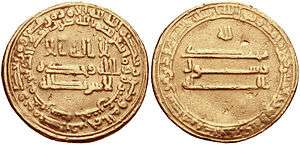 Gold dinar of al-Ma'mun, minted in Egypt in 830/1 | |||||
| 7th Caliph of the Abbasid Caliphate | |||||
| Reign | 27 September 813 – 7 August 833 | ||||
| Predecessor | al-Amin | ||||
| Successor | al-Mu'tasim | ||||
| Born | September 14, 786 Baghdad | ||||
| Died | August 7, 833 (aged 46) Tarsus, Abbasid Caliphate, now Mersin Province, Turkey | ||||
| Burial | |||||
| Consort | List
| ||||
| Issue |
| ||||
| |||||
| Dynasty | Abbasid | ||||
| Father | Harun al-Rashid | ||||
| Mother | Marajil bint Ustadhsis | ||||
| Religion | Mu'tazili Islam[1] | ||||
Birth and education
Abdallah, the future al-Ma'mun, was born in Baghdad on the night of the 13 to 14 September 786 CE to Harun al-Rashid and his concubine Marajil, from Badghis. On the same night, which later became known as the "night of the three caliphs", his uncle al-Hadi died and was succeeded by Ma'mun's father, Harun al-Rashid, as ruler of the Abbasid Caliphate.[2] Marajil died soon after his birth, and Abdallah was raised by Harun al-Rashid's wife, Zubayda, herself of high Abbasid lineage as the granddaughter of Caliph al-Mansur (r. 754–775).[3] As a young prince, Abdallah received a thorough education: al-Kisa'i tutored him in classical Arabic, Abu Muhammad al-Yazidi in adab, and he received instruction in music and poetry. He was trained in fiqh by al-Hasan al-Lu'lu'i, showing particular excellence in the Hanafi school, and in the hadith, becoming himself active as a transmitter.[3] According to M. Rekaya, "he was distinguished by his love of knowledge, making him the most intellectual caliph of the Abbasid family, which accounts for the way in which his caliphate developed".[3]
Appointment as successor and Governor of Khurasan
Although Abdallah was the oldest of his sons, in 794 Harun named the second-born Muhammad, born in April 787 to Zubayda, as the first in line of succession. This was the result of family pressure on the Caliph, reflecting Muhammad's higher birth, as both parents descended from the Abbasid dynasty; indeed, he remained the only Abbasid caliph to claim such descent. Muhammad received the oath of allegiance (bay'ah) with the name of al-Amin ("The Trustworthy"), first in Khurasan by his guardian, the Barmakid al-Fadl ibn Yahya, and then in Baghdad.[3] Abdallah was recognized as second heir only after entering puberty, in 799, under the name al-Ma'mun ("The Trusted One"), with another Barmakid, Ja'far ibn Yahya, as his guardian. At the same time, a third heir, al-Qasim, named al-Mu'tamin, was appointed, under the guardianship of Abd al-Malik ibn Salih.[3]
These arrangements were confirmed and publicly proclaimed in 802, when Harun and the most powerful officials of the Abbasid government made the pilgrimage to Mecca. Al-Amin would succeed Harun in Baghdad, but al-Ma'mun would remain al-Amin's heir and would additionally rule over an enlarged Khurasan.[3] This was an appointment of particular significance, as Khurasan had been the starting-point of the Abbasid Revolution which brought the Abbasids to power, and retained a privileged position among the Caliphate's provinces. Furthermore, the Abbasid dynasty relied heavily on Khurasanis as military leaders and administrators. Many of the original Khurasani Arab army (Khurasaniyya) that came west with the Abbasids were given estates in Iraq and the new Abbasid capital, Baghdad, and became an elite group known as the abnāʾ al-dawla ("sons of the state/dynasty").[4][5] This large-scale presence of an Iranian element in the highest circles of the Abbasid state, with the Barmakid family as its most notable representatives, was certainly a factor in the appointment of al-Ma'mun, linked through his mother with the eastern Iranian provinces, as heir and governor of Khurasan.[6] The stipulations of the agreement, which were recorded in detail by the historian al-Tabari, accorded al-Mamun's Khurasani viceroyalty extensive autonomy. However, modern historians consider that these accounts may have been distorted by later apologists of al-Ma'mun in the latter's favour.[7] Harun's third heir, al-Mu'tamin, received responsibility over the frontier areas with the Byzantine Empire in Upper Mesopotamia and Syria.[3][8]
Very quickly, the latent rivalry between the two brothers had important repercussions: almost immediately after the court returned to Baghdad in January 803, the Abbasid elites were shaken by the abrupt fall of the Barmakid family from power. On the one hand, this event may reflect the fact that the Barmakids had become indeed too powerful for the Caliph's liking, but its timing suggests that it was tied to the succession issue as well: with al-Amin siding with the abnāʾ and al-Ma'mun with the Barmakids, and the two camps becoming more estranged every day, if al-Amin was to have a chance to succeed, the power of the Barmakids had to be broken.[3][9][10]
Al-Fadl ibn Sahl, a Kufan of Iranian origin whose father had converted to Islam and entered Barmakid service, replaced Ja'far ibn Yahya as al-Ma'mun's tutor. In 806 he also became al-Ma'mun's secretary (katib), an appointment that marked him out as the chief candidate for the vizierate should al-Ma'mun succeed to the throne.[3] In 804, al-Ma'mun married his cousin, Umm Isa, a daughter of the Caliph al-Hadi (r. 785–786). The couple had two sons, Muhammad al-Asghar and Abdallah.[3]
The years after the fall of the Barmakids saw an increasing centralization of the administration and the concomitant rise of the influence of the abnāʾ, many of whom were now dispatched to take up positions as provincial governors and bring these provinces under closer control from Baghdad.[10] This led to unrest in the provinces, especially Khurasan, where local elites had a long-standing rivalry with the aabnāʾ and their tendency to control of the province (and its revenues) from Iraq.[11] The harsh taxation imposed by a prominent member of the abnāʾ, Ali ibn Isa ibn Mahan, even led to a revolt under Rafi ibn al-Layth, which eventually forced Harun himself, accompanied by al-Ma'mun and the powerful chamberlain (hajib) and chief minister al-Fadl ibn al-Rabi, to travel to the province in 808. Al-Ma'mun was sent ahead with part of the army to Marv, while Harun stayed at Tus, where he died on 24 March 809.[3][10][12]
Abbasid civil war
In 802 Harun al-Rashid, father of al-Maʾmūn and al-Amin, ordered that al-Amin succeed him, and al-Ma'mun serve as governor of Khurasan and as caliph after the death of al-Amin. In the last days of Harun's life his health was declining and saw in a dream Musa ibn Jafar sitting in a chamber praying and crying, which made Harun remember how hard he had struggled to establish his own caliphate. He knew the personalities of both his sons and decided that for the good of the Abbasid dynasty, al-Maʾmūn should be caliph after his death, which he confided to a group of his courtiers. One of the courtiers, Fadl ibn Rabi', did not abide by Harun's last wishes and convinced many in the lands of Islam that Harun's wishes had not changed. Later the other three courtiers of Harun who had sworn loyalty to Harun by supporting al-Maʾmūn, namely, 'Isa Jarudi, Abu Yunus, and Ibn Abi 'Umran, found loopholes in Fadl's arguments, and Fazl admitted Harun had appointed al-Maʾmūn after him, but, he argued, since Harun was not in his right mind, his decision should not be acted upon. Al-Maʾmūn was reportedly the older of the two brothers, but his mother was a Persian woman while al-Amin's mother was a member of the reigning Abbasid family. After al-Rashid's death in 809, the relationship between the two brothers deteriorated. In response to al-Ma'mun's moves toward independence, al-Amin declared his own son Musa to be his heir. This violation of al-Rashid's testament led to a succession struggle. Al-Amin assembled a massive army at Baghdad with 'Isa ibn Mahan at its head in 811 and invaded Khorasan, but al-Maʾmūn's general Tahir ibn al-Husayn (d. 822) destroyed the army and invaded Iraq, laying siege to Baghdad in 812. In 813 Baghdad fell, al-Amin was beheaded, and al-Maʾmūn became the undisputed Caliph.[13]
Internal strife
There were disturbances in Iraq during the first several years of al-Maʾmūn's reign, while the caliph was in Merv. On 13 November 815, Muhammad ibn Ja'far al-Sadiq (Al-Dibaj) claimed the Caliphate for himself in Mecca. He was defeated and he quickly abdicated asserting that he had only become caliph on news that al-Ma'mun had died. Lawlessness in Baghdad led to the formation of neighborhood watches.
In A.H. 201 (817 AD) al-Ma'mun forced Ali ar-Rida, a/k/a Imam Reza, to move from Madina to Merv. Imam Reza, the eighth descendant of Muhammad, was named his heir. This was not easily accepted by the Abbasid leaders but was widely seen as a political move by al-Ma'mun since he was fearful of the widespread sympathy towards the Ahl al-Bayt. Al-Ma'mun's plan was to keep watch over Imam Reza. However, his plans did not succeed due to the growing popularity of the Imam in Merv. People from all over the Muslim world traveled to meet the prophet's grandson and listen to his teachings and guidance.
After a debate al-Ma'mun had set up with the greatest scholars of the world's religions to humiliate the Imam, the victorious Imam informed al-Ma'mun that his grand vizier, Fazl ibn Sahl, had not been informing him of everything. In Baghdad, the people believed that al-Maʾmūn was unseated, due to rumors spread by Fazl ibn Sahl, and so gave their allegiance to al-Mamun's uncle Ibrahim ibn Mehdi. Al-Ma'mun set out for Baghdad on 12 April 818. At Tus, he stopped to visit his father's grave. Al-Ma'mun was troubled by the widespread support for Imam Reza, a descendant of the prophet Muhammad, and the betrayal of his grand vizier. With the aim of gaining Abbasid support and the establishment of a new base for his rule in Baghdad, al-Ma'mun went on to dispose of Ali Ar-Rida by administering poison, and arranging the murder of Fazl ibn Sahl. On the last day of Safar in 203 AH, Imam Reza died, and was buried thereafter beside Al-Ma'mun's father Hārūn al-Rashid. Following the death of Imam Reza, a great revolt took place in Khurasan. Al-Ma’mun tried unsuccessfully to absolve himself of the crime.
After arrival in Baghdad
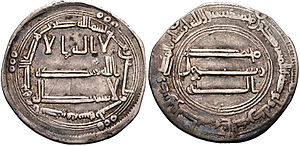
Muhammad ibn Jarir al-Tabari states that al-Ma'mun entered Baghdad on 11 August 819 (v. 32, p. 95). He wore green and had others do so. Informed that compliance with this command might arouse popular opposition to the colour, on 18 August he reverted to traditional Abbasid black. While Baghdad became peaceful, there were disturbances elsewhere. In A.H. 210 (825–826 CE) Abdullah ibn Tahir al-Khurasani secured Egypt for al-Ma'mun, freeing Alexandria from Andalusians and quelling unrest. The Andalusians moved to Crete, where al-Tabari records their descendants were still living in his day (see Emirate of Crete). Abdallah returned to Baghdad in 211 Hijri (826–827 C.E.) bringing the defeated rebels with him.
Also, in 210 Hijri (825–826 CE), there was an uprising in Qum sparked by complaints about taxes. After it was quashed, the tax assessment was set significantly higher. In 212 Hijri (827–828 CE), there was an uprising in Yemen. In 214 (829–30 CE), Abu al-Razi, who had captured one Yemeni rebel, was killed by another. Egypt continued to be unquiet. Sindh was rebellious. In 216 (831–832 CE), Ghassan ibn 'Abbad subdued it. An ongoing problem for al-Ma'mun was the uprising headed by Babak Khorramdin. In 214 Babak routed a Caliphate army killing its commander Muhammad ibn Humayd.
Wars with Byzantium
By the time al-Maʾmūn became Caliph, the Arabs and the Byzantine Empire had settled down into border skirmishing, with Arab raids deep into Anatolia to capture booty and Christians to be enslaved. The situation changed however with the rise to power of Michael II in 820 AD. Forced to deal with the rebel Thomas the Slav, Michael had few troops to spare against a small Andalusian invasion of 40 ships and 10,000 men against Crete, which fell in 824 AD. A Byzantine counter offensive in 826 AD failed miserably. Worse still was the invasion of Sicily in 827 by Arabs of Tunis. Even so, Byzantine resistance in Sicily was fierce and not without success whilst the Arabs became quickly plagued by internal squabbles. That year, the Arabs were expelled from Sicily but they were to return.
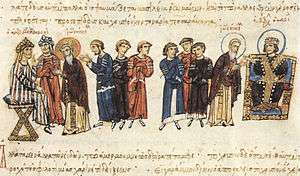
In 829, Michael II died and was succeeded by his son Theophilos. Theophilos experienced mixed success against his Arab opponents. In 830 AD the Arabs returned to Sicily and, after a year-long siege, took Palermo. For the next 200 years they were to remain there to complete their conquest, which was never short of Christian counters. Al-Ma'mun meanwhile launched an invasion of Anatolia in 830 AD, taking a number of Byzantine forts; he spared the surrendering Byzantines. Theophilos, for his part, captured Tarsus in 831. The next year, learning the Byzantines had killed some sixteen hundred people, al-Ma'mun returned. This time some thirty forts fell to the Caliphate's forces, with two Byzantine defeats in Cappadocia.
Theophilos wrote to al-Ma'mun. The Caliph replied that he carefully considered the Byzantine ruler's letter, noticed it blended suggestions of peace and trade with threats of war and offered Theophilos the options of accepting the shahada, paying tax or fighting. Al-Ma'mun made preparations for a major campaign, but died on the way while leading an expedition in Tyana.
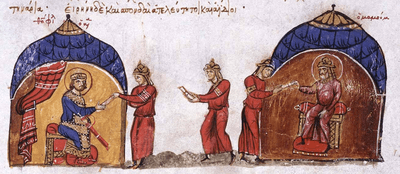
Al-Ma'mun's relations with the Byzantines are marked by his efforts in the translation of Greek philosophy and science. Al-Ma'mun gathered scholars of many religions at Baghdad, whom he treated magnificently. He sent an emissary to the Byzantine Empire to collect the most famous manuscripts there, and had them translated into Arabic.[14] As part of his peace treaty with the Byzantine Emperor, Al-Ma'mun was to receive a number of Greek manuscripts annually, one of these being Ptolemy's astronomical work, the Almagest.[15]
Al-Ma'mun's reign
Al-Ma'mun conducted, in the plains of Mesopotamia, two astronomical operations intended to determine the value of a terrestrial degree. The crater Almanon on the moon is named in recognition of his contributions to astronomy.
Al-Ma'mun's record as an administrator is also marked by his efforts toward the centralization of power and the certainty of succession. The Bayt al-Hikma, or House of Wisdom, was established during his reign.[16] The ulama emerged as a real force in Islamic politics during al-Ma'mun's reign for opposing the mihna, which was initiated in 833, four months before he died.
Michael Hamilton Morgan in his book "Lost History" describes al-Ma'mun as a man who 'Loves Learning.' al-Ma'mun once defeated a Byzantine Emperor in a battle and as a tribute, he asked for a copy of Almagest, Ptolemy's Hellenistic compendium of thoughts on astronomy written around A.D. 150[17]
The 'mihna', is comparable to Medieval European inquisitions in the sense that it involved imprisonment, a religious test, and a loyalty oath. The people subject to the mihna were traditionalist scholars whose social influence was uncommonly high. Al-Ma'mun introduced the mihna with the intention to centralize religious power in the caliphal institution and test the loyalty of his subjects. The mihna had to be undergone by elites, scholars, judges and other government officials, and consisted of a series of questions relating to theology and faith. The central question was about the createdness of the Qur'an, if the interrogatee stated he believed the Qur'an to be created, rather than coeternal with God, he was free to leave and continue his profession.
The controversy over the mihna was exacerbated by al-Ma'mun's sympathy for Mu'tazili theology and other controversial views. Mu'tazili theology was deeply influenced by Aristotelian thought and Greek rationalism, and stated that matters of belief and practice should be decided by reasoning. This opposed the traditionalist and literalist position of Ahmad ibn Hanbal and others, according to which everything a believer needed to know about faith and practice was spelled out literally in the Qur'an and the Hadith. Moreover, the Mu'tazilis stated that the Qur'an was created rather than coeternal with God, a belief that was shared by the Jahmites and parts of Shi'a, among others, but contradicted the traditionalist-Sunni opinion that the Qur'an and the Divine were coeternal.
During his reign, alchemy greatly developed. Pioneers of the science were Jabir Ibn Hayyan and his student Yusuf Lukwa, who was patronized by Al-Ma'mun. Although he was unsuccessful in transmuting gold, his methods greatly led to the patronization of pharmaceutical compounds.[18]
Caliph Al-Ma'mun was a pioneer of cartography having commissioned a world map from a large group of astronomers and geographers. The map is presently in an encyclopedia in Topkapi Sarai, a Museum in Istanbul. The map shows large parts of the Eurasian and African continents with recognizable coastlines and major seas. It depicts the world as it was known to the captains of the Arab sailing dhows which used the monsoon wind cycles to trade over vast distances (by the 9th century, Arab sea traders had reached Guangzhou, in China). The maps of the Greeks and Romans reveal a good knowledge of closed seas like the Mediterranean but little knowledge of the vast ocean expanses beyond.[19]
Although al-Mahdi had proclaimed that the caliph was the protector of Islam against heresy, and had also claimed the ability to declare orthodoxy, religious scholars in the Islamic world believed that al-Ma'mun was overstepping his bounds in the mihna. The penalties of the mihna became increasingly difficult to enforce as the ulema became firmer and more united in their opposition. Although the mihna persisted through the reigns of two more caliphs, al-Mutawakkil abandoned it in 848. The failure of the mihna seriously damaged Caliphal authority and ruined the reputation of the office for succeeding caliphs. The caliph would lose much of his religious authority to the opinion of the ulema as a result of the mihna.
The ulema and the major Islamic law schools became truly defined in the period of al-Ma'mun, and Sunnism--as a religion of legalism--became defined in parallel. Doctrinal differences between Sunni and Shi'a Islam began to become more pronounced. Ibn Hanbal, the founder of the Hanbali legal school, became famous for his opposition to the mihna. Al-Ma'mun's simultaneous opposition and patronage of intellectuals led to the emergence of important dialogues on both secular and religious affairs, and the Bayt al-Hikma became an important center of translation for Greek and other ancient texts into Arabic. This Islamic renaissance spurred the rediscovery of Hellenism and ensured the survival of these texts into the European renaissance.
Al-Ma'mun had been named governor of Khurasan by Harun, and after his ascension to power, the caliph named Tahir as governor for his military services in order to assure his loyalty. It was a move that al-Ma'mun soon regretted, as Tahir and his family became entrenched in Iranian politics and became increasingly powerful in the state, contrary to al-Ma'mun's desire to centralize and strengthen Caliphal power. The rising power of the Tahirid family became a threat as al-Ma'mun's own policies alienated them and his other opponents.
Al-Ma'mun also attempted to divorce his wife during his reign, who had not borne him any children. His wife hired a Syrian judge of her own before al-Ma'mun was able to select one himself; the judge, who sympathized with the caliph's wife, refused the divorce. Following al-Ma'mun's experience, no further Abbasid caliphs were to marry, preferring to find their heirs in the harem.
Al-Ma'mun, in an attempt to win over the Shi'a Muslims to his camp, named the eighth Imam, Ali ar-Rida, his successor, if he should outlive al-Ma'mun. Most Shi'ites realized, however, that ar-Rida was too old to survive him and saw al-Ma'mun's gesture as empty; indeed, Al-Ma'mun poisoned Ali ar-Rida who then died in 818. The incident served to further alienate the Shi'ites from the Abbasids, who had already been promised and denied the Caliphate by al-'Abbas.
The Abbasid empire grew somewhat during the reign of al-Ma'mun. Hindu rebellions in Sindh were put down, and most of Afghanistan was absorbed with the surrender of the leader of Kabul. Mountainous regions of Iran were brought under a tighter grip of the central Abbasid government, as were areas of Turkestan.
In 832, al-Ma'mun led a large army into Egypt to put down the last great Bashmurite revolt.[20] While there he ordered the breaching of the Great Pyramid of Giza looking for knowledge and treasure. He entered the pyramid by tunneling into the Great Pyramid near where tradition located the original entrance. The resulting passage, which was later named the "Robbers' Tunnel" is the path along which tourists enter the pyramid today.
Personal characteristics
Al-Tabari (v. 32, p. 231) describes al-Ma'mun as of average height, light complexion, handsome and having a long beard losing its dark colour as he aged. He relates anecdotes concerning the caliph's ability to speak concisely and eloquently without preparation, his generosity, his respect for Muhammad and religion, his sense of moderation, justice and his love of poetry and his insatiable passion for physical intimacy.
Ibn Abd Rabbih in his Unique Necklace (al-'iqd al-Farid), probably drawing on earlier sources, makes a similar description of al-Ma'mun, whom he described as of light complexion and having slightly blond hair, a long thin beard, and a narrow forehead.
Family
Al-Ma'mun had one official wife, Umm Isa, a daughter of his uncle al-Hadi (r. 785–786), whom he married when he was eighteen years old. They had two sons, Muhammad al-Asghar, and Abdallah.[3] Al-Ma'mun had also numerous concubines.[3] One of them, Sundus, bore him five sons, among whom was al-Abbas, who rose to become a senior military commander at the end of al-Ma'mun's reign and a contender for the throne.[21]
Death
Al-Tabari (v.32, pp. 224–231) recounts how Al-Ma'mun was sitting on the river bank telling those with him how splendid the water was. He asked what would go best with this water and was told a specific kind of fresh dates. Noticing supplies arriving, he asked someone to check whether such dates were included. As they were, he invited those with him to enjoy the water with these dates. All who did this fell ill. Others recovered, but Al-Ma'mun died. He encouraged his successor to continue his policies and not burden the people with more than they could bear. This was on 9 August 833.
Al-Ma'mun died near Tarsus. The city's major mosque (Tarsus Grand Mosque), contains a tomb reported to be his. He was not succeeded by his son, Al-Abbas ibn al-Ma'mun, but by his half-brother, al-Mu'tasim.
Legacy
Almanon is a lunar impact crater that lies in the rugged highlands in the south-central region of the Moon. It was named after Abbasid Caliph and astronomer Al-Ma'mun.[22]
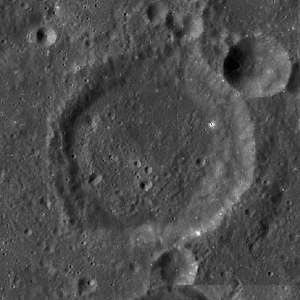
It is located to the south-southeast of Abulfeda, and to the north-northeast of the smaller crater Geber. The crater chain designated Catena Abulfeda forms a line between the south rim of Abulfeda and the north rim of Almanon, continuing for a length of about 210 kilometers to the Rupes Altai scarp.
Religious beliefs
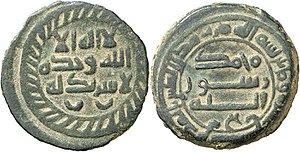
Al-Maʾmūn’s religious beliefs are a subject of controversy, to the point where other Abbasids,[23] as well as later Islamic scholars, called him a Shia Muslim. For instance, Sunni scholars al-Dhahabi, Ibn Kathir, Ibn Khaldun and al-Suyuti explicitly held the belief that al-Ma'mun was a Shi'a.[24] The arguments for his alleged Shi’ism include that, in 816/817, when Ali al-Ridha, the Prophet's descendant, refused designation as sole Caliph, Al-Ma'mun officially designated him as his appointed successor. The official Abbasid coins were minted showing Al-Ma'mun as a Caliph and al-Ridha as his successor.[25] Other arguments were that: the Caliphate’s official black colour was changed to the Prophetic green; in 210 AH/825 CE, he wrote to Qutham b. Ja'far, the ruler of Medina, to return Fadak to the descendants of Muhammad through his daughter, Fatima; he restored nikah mut'ah, previously banned by Umar ibn al-Khattab, but practiced under Muhammad and Abu Bakr; in 211 AH/826 CE, al-Ma'mun expressed his antipathy to those who praised Mu'awiya ibn Abi Sufyan, and punished such people;[26] in 212 AH/827 CE, al-Ma'mun announced the superiority of Ali ibn Abu Talib over Abu Bakr and 'Umar b. al-Khattab;[27] in 833 CE, under the influence of Muʿtazila rationalist thought, he initiated the mihna ordeal, where he accepted the Shia argument that the Quran was created at some point over the Sunni belief that the Book was coeternal with God.
However, mainstream Shi’ite belief is that al-Ma'mun was responsible for Ali al-Ridha’s poisoning and eventual death in 818 CE. In the ensuing power struggle, other Abbasids sought to depose Ma'mun in favor of Ibrahim ibn al-Mahdi, Ma'mun's uncle;[28] therefore, getting rid of al-Ridha was the only realistic way of retaining united, absolute, unopposed rule.[29] Al-Ma'mūn ordered that al-Ridha be buried next to the tomb of his own father, Harun al-Rashid, and showed extreme sorrow in the funeral ritual and stayed for three days at the place. Muhammad al-Jawad, Ali al-Ridha’s son and successor, lived unopposed and free during the rest of Al-Ma'mūn’s reign (till 833 CE). The Caliph summoned al-Jawad to Baghdad in order to marry his daughter, Ummul Fadhl. This apparently provoked strenuous objections by the Abbasids. According to Ya'qubi, al-Ma'mun gave al-Jawad one hundred thousand dirham and said, "Surely I would like to be a grandfather in the line of the Apostle of God and of Ali ibn Abu Talib."[30]
References
- "Mu'tazilah". Britannica. Encylopaedia Britannica, inc. 3 April 2020. Retrieved 31 May 2020.CS1 maint: date and year (link)
- Rekaya, M. (24 April 2012). "al-Maʾmūn". Encyclopaedia of Islam, Second Edition. Retrieved 20 September 2019.
- Rekaya 1991, p. 331.
- El-Hibri 2010, p. 274.
- Kennedy 2004, pp. 133–135.
- El-Hibri 2010, p. 282.
- El-Hibri 2010, pp. 282–283.
- Kennedy 2004, p. 142.
- Kennedy 2004, pp. 142–143.
- El-Hibri 2010, p. 283.
- Kennedy 2004, p. 144.
- Kennedy 2004, pp. 144–145.
- Kennedy, Hugh (1986). The Prophet and the Age of the Caliphates (2nd ed.). London and New York: Pearson Longman. pp. 148–150.
- Lee S. Tesdell, "Greek Rhetoric and Philosophy in Medieval Arabic Culture: The State of the Research," in: Discourses of Power: Grammar and Rhetoric in the Middle Ages, ed. Carol Poster and Richard Utz (Evanston, IL: Northwestern University Press, 1999), pp. 51–58.
- Angelo, Joseph (2009). Encyclopedia of Space and Astronomy. p. 78. ISBN 9781438110189.
- Goldschmidt, Arthur (2002). A concise history of the Middle East. Boulder, Colorado: Westview Press. pp. 78. ISBN 978-0-8133-3885-9.
- Michael Hamilton Morgan "Lost History", page. 57
- E.J. Brill's First Encyclopaedia of Islam (1993), Vol. 4, p. 1011
- Rechnagel, Charles (15 October 2004). "World: Historian Reveals Incredible Contributions of Muslim Cartographers". Radio Free Europe/Radio Liberty. Retrieved 5 March 2015.
- Gabra 2003, p. 112.
- Turner 2013.
- "Al-Ma'mun". Gazetteer of Planetary Nomenclature. USGS Astrogeology Research Program.
- Naqawī, "Taʾthīr-i qīyāmhā-yi ʿalawīyān", p. 141.
- Dhahabī, Siyar aʿlām al-nubalāʾ, vol. 11, p. 236; Ibn Kathīr, al-Bidāya wa l-nihāya, vol. 10, p. 275-279; Ibn khaldūn. al-ʿIbar, vol. 2, p. 272; Suyūṭī, Tārīkh al-khulafāʾ, p. 363.
- https://www.vcoins.com/en/stores/cyrus_coins/28/product/item_13113_abbasid_medieval_islam_almamun_ah_194218_silver_dirham_204ah_isfahan_mint__with_ali_ibn_musa_alrida_as_heir__rare_album_224__difficult_to_find/564808/Default.aspx
- Suyūṭī, Tārīkh al-khulafāʾ, p. 364.
- Suyūṭī, Tārīkh al-khulafāʾ, p. 364.
- Donaldson, Dwight M. (1933). The Shi'ite Religion: A History of Islam in Persia and Irak. BURLEIGH PRESS. pp. 161–170.
- According to Madelung the unexpected death of the Alid successor, "whose presence would have made any reconciliation with the powerful ʿAbbasid opposition in Baghdad virtually impossible, must indeed arouse strong suspicion that Ma'mun had had a hand in the deaths."
- Donaldson, Dwight M. (1933). The Shi'ite Religion: A History of Islam in Persia and Iraḳ. AMS Press. pp. 190–197.
Further reading
- Bosworth, C.E., ed. (1987). The History of al-Ṭabarī, Volume XXXII: The Reunification of the ʿAbbāsid Caliphate: The Caliphate of al-Maʾmūn, A.D. 813–33/A.H. 198–213. SUNY Series in Near Eastern Studies. Albany, New York: State University of New York Press. ISBN 978-0-88706-058-8.
- Cooperson, Michael (2005). Al Ma'mun. Makers of the Muslim world. Oxford: Oneworld. ISBN 9781851683864.CS1 maint: ref=harv (link)
- Daniel, Elton L. (1979). The Political and Social History of Khurasan under Abbasid Rule, 747–820. Minneapolis & Chicago: Bibliotheca Islamica, Inc. ISBN 978-0-88297-025-7.
- El-Hibri, Tayeb (1999). "Al-Maʾmūn: the heretic Caliph". Reinterpreting Islamic Historiography: Hārūn al-Rashı̄d and the Narrative of the ʿAbbāsid Caliphate. Cambridge University Press. pp. 95–142. ISBN 0-521-65023-2.CS1 maint: ref=harv (link)
- El-Hibri, Tayeb (2010). "The empire in Iraq, 763–861". In Robinson, Chase F. (ed.). The New Cambridge History of Islam, Volume 1: The Formation of the Islamic World, Sixth to Eleventh Centuries. Cambridge: Cambridge University Press. pp. 269–304. ISBN 978-0-521-83823-8.
- Fishbein, Michael, ed. (1992). The History of al-Ṭabarī, Volume XXXI: The War Between Brothers: The Caliphate of Muḥammad al-Amīn, A.D. 809–813/A.H. 193–198. SUNY Series in Near Eastern Studies. Albany, New York: State University of New York Press. ISBN 978-0-7914-1085-1.
- Gabra, Gawdat (2003). "The Revolts of the Bashmuric Copts in the Eighth and Ninth Centuries". In W. Beltz (ed.). Die koptische Kirche in den ersten drei islamischen Jahrhunderten. Institut für Orientalistik, Martin-Luther-Universität. pp. 111–119.CS1 maint: ref=harv (link)
- John Bagot Glubb The Empire of the Arabs, Hodder and Stoughton, London, 1963.
- E. de la Vaissière, Samarcande et Samarra. Elites d'Asie centrale dans l'empire Abbasside, Peeters, 2007
- Dimitri Gutas, Greek Thought, Arabic culture: the Graeco-Arabic translation movement in Baghdad and early Abbasid society Routledge, London, 1998
- Hugh N. Kennedy, The Early Abbasid Caliphate, a political History, Croom Helm, London, 1981
- Kennedy, Hugh (2004). The Prophet and the Age of the Caliphates: The Islamic Near East from the 6th to the 11th Century (Second ed.). Harlow: Longman. ISBN 978-0-582-40525-7.
- John Nawas, A Reexamination of three current explanations for Al-Ma’mun's introduction of the Mihna, International Journal of Middle East Studies 26, (1994) pp. 615–629
- John Nawas, The Mihna of 218 A.H./833 A.D. Revisited: An Empirical Study, Journal of the American Oriental Society 116.4 (1996) pp. 698–708
- Nawas, John Abdallah (2015). Al-Maʼmūn, the Inquisition, and the Quest for Caliphal Authority. Atlanta, Georgia: Lockwood Press. ISBN 978-1-937040-55-0.CS1 maint: ref=harv (link)
- Rekaya, M. (1991). "al-Maʾmūn". In Bosworth, C. E.; van Donzel, E. & Pellat, Ch. (eds.). The Encyclopaedia of Islam, New Edition, Volume VI: Mahk–Mid. Leiden: E. J. Brill. pp. 331–339. ISBN 90-04-08112-7.
- Peter Tompkins, "Secrets of the Great Pyramid", chapter 2, Harper and Row, 1971.
- Turner, John P. (2013). "al-ʿAbbās b. al-Maʾmūn". In Fleet, Kate; Krämer, Gudrun; Matringe, Denis; Nawas, John; Rowson, Everett (eds.). Encyclopaedia of Islam, THREE. Brill Online. doi:10.1163/1573-3912_ei3_COM_24639. ISSN 1873-9830.
External links
| Wikisource has original works written by or about: al-Maʾmun |
- (in English) Al-Mamum: Building an Environment for Innovation
- Berggren, Len (2007). "Maʾmūn: Abū al‐ʿAbbās ʿAbdallāh ibn Hārūn al‐Rashīd". In Thomas Hockey; et al. (eds.). The Biographical Encyclopedia of Astronomers. New York: Springer. p. 733. ISBN 978-0-387-31022-0. (PDF version)
Al-Ma'mun Born: 786 Died: 833 | ||
| Sunni Islam titles | ||
|---|---|---|
| Preceded by Al-Amin |
Caliph of Islam Abbasid Caliph 813 – 9 August 833 |
Succeeded by Al-Mu'tasim |